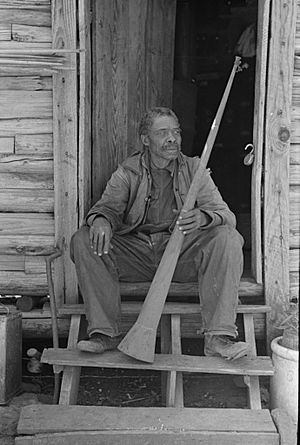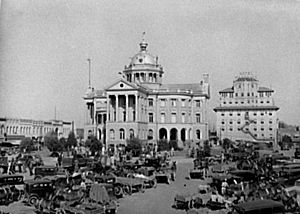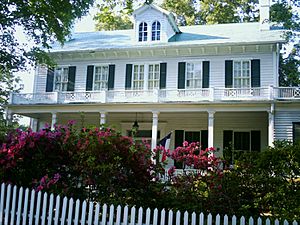History of Marshall, Texas facts for kids
Marshall, Texas, has a long and interesting history. It started as an important administrative center for the Republic of Texas. Over time, it grew into one of the largest cities in early Texas. During the American Civil War, Marshall became a key city for the Confederacy. Later, it became a major hub for railroads in the United States. Marshall also played an important role in the Civil Rights Movement. After a period of economic decline in the late 20th century, the city began to grow again in the 1990s and early 21st century.
Contents
Marshall's Early Days: The 1800s
Marshall's history began when the first known settlers arrived in 1839. Before that, Caddo and other Native American groups lived and traveled through the area. However, there wasn't a permanent town where Marshall is today.
In 1841, leaders were looking for a new county seat for Harrison County. A local settler named Peter Whetstone offered some of his land. He promised to build a church and a school. The rest of the land would be divided into 190 lots for people to buy.
County leaders were worried about the water quality. Previous county seats had bad water, which led to sickness and flooding. Whetstone supposedly convinced them the water was good by sharing whiskey from an oak tree. While this story is famous, some historians think it might not be completely true.
Whetstone's friend, Isaac Van Zandt, designed the city. He named it after John Marshall, a famous judge. The Republic of Texas officially recognized Marshall as a city in 1841.
Marshall quickly grew because it was a gateway to Texas. Many major stagecoach routes passed through it. The city's importance grew even more when it got a telegraph line to New Orleans. This made Marshall the first city in Texas with telegraph service. Several schools were also built, many supported by Whetstone, even though he couldn't read or write himself.
Marshall During the Civil War
By 1860, Marshall was the fifth largest city in Texas. It was called the "first metropolis of East Texas" and was the center of the richest county. Harrison County had more enslaved people than any other county in Texas. This made it a strong supporter of the Confederacy.
In the 1850s, many skilled enslaved people lived in Marshall. White workers even protested, saying their jobs were being taken. When Texas Governor Sam Houston refused to support the Confederacy, Marshall's own Edward Clark became governor. Later, Marshall also produced Texas' third Confederate governor, Pendleton Murrah.
Marshall became a very important Confederate city. It served as the capital for Missouri's Confederate government, which was in exile. The city produced gunpowder and other supplies for the Confederate Army. It also hosted three important meetings for Confederate and Native American leaders from west of the Mississippi River.
After the fall of Vicksburg, Mississippi, Marshall became the main center for civil authority and the postal department for the Trans-Mississippi region. The city remained influential throughout the war. It hosted Confederate governors during the Marshall Conferences in 1862, 1863, and 1865. It's even thought that Marshall might have been the target of a failed Union attack. Towards the end of the war, the Confederate government in Richmond, Virginia, sent a lot of money and stamps to Marshall. This suggests Marshall might have been a planned escape location for the government.

Reconstruction and the Railroad Era
Union forces arrived in Marshall on June 17, 1865. This was two days before the famous Juneteenth announcement in Galveston. During Reconstruction, Marshall had an office for the Freedmen's Bureau, which helped formerly enslaved people. Union troops were also based there.
In 1873, the Methodist Episcopal Church founded Wiley College to educate formerly enslaved men. Many African Americans moved to Marshall looking for new chances and protection. However, in 1878, a group called the Citizens Party took control. Led by former Confederate General Walter P. Lane, they forced Union supporters, Republicans, and many African Americans out of town. The Lanes declared Marshall and Harrison County "redeemed" from Union and African-American control. Despite this, the African-American community continued to make progress. Bishop College was established in 1881, and Wiley College was officially recognized in 1882.
Marshall's "Railroad Era" began in the early 1870s. Citizens of Harrison County offered a large amount of money to the Texas and Pacific Railway. The City of Marshall also offered land. In return, the company would move its workshops and main offices to Marshall. The president of T&P, Jay Gould, agreed.
The city immediately saw a huge increase in population. By 1880, Marshall was one of the largest cotton markets in the South. The city's new wealth was clear when the first department store in Texas, J. Weisman and Co., opened in 1878. Many Jewish people also moved to Marshall after the railroad arrived, and a temple was built in 1900.
During this wealthy period, many of Marshall's historic homes were built. One example is Maplecroft, built for James F. Starr in 1871. It's a large, two-story house with Greek Revival and Victorian styles. Skilled workers and building materials were even shipped from New Orleans to Marshall to build such homes.
Marshall Pottery, a company that makes pottery, was founded in Marshall in 1895 by W. F. Rocker. He chose East Texas because it had plenty of water and white clay.
Even with the prosperity of the railroad era, poverty was still a problem for all races. Tensions between white people and African Americans grew as segregation became stronger in the city. In the rural areas of Harrison County, white and Black neighbors often lived closer together. However, racism was still a part of daily life. Some former slave owners even divided their land and gave it to their former enslaved people, which may have added to these tensions.
Marshall in the 20th Century
In the late 1800s and early 1900s, children of both races were taught to accept segregation.

Civil Rights Progress
Three graduates of Wiley College were inspired by their professor, Melvin B. Tolson. They helped to break down Jim Crow laws at local, state, and national levels.
- Fred Lewis, who was the secretary of the NAACP in Harrison County, challenged the oldest White Citizens Party in Texas. He fought against the Jim Crow laws they enforced. This led to the Perry v. Cyphers verdict, which ended Jim Crow in the county.
- Heman Sweatt tried to enroll in the University of Texas Law School. He was denied because of his skin color. He sued, and the Texas Supreme Court ordered that postgraduate studies in Texas must be desegregated in the Sweatt v. Painter decision.
- James L. Farmer, Jr. became a leader of the Freedom Rides and helped start the Congress of Racial Equality.
The fight for civil rights continued into the 1960s, 1970s, and 1980s. In the 1960s, students organized the first sit-ins in Texas. These took place in the rotunda of the county courthouse on Whetstone Square. Their goal was to end segregation in public schools. By 1970, all Marshall public schools were integrated.
Also in 1970, Carolyn Abney became the first woman elected to the city commission. In April 1975, local businessman Sam Birmingham became the first African American elected to the city commission. In the 1980s, he became Marshall's first African-American mayor. When Birmingham retired in 1989 due to health, his wife, Jean Birmingham, took his place. She became the first African-American woman to serve on the commission.
Economic Changes
During the first half of the 20th century, the Texas & Pacific Railroad was very successful. Marshall's industries also grew when a huge oil field was discovered near Kilgore in 1930.
However, Marshall's railroad industry later declined. This happened because trains started using diesel instead of steam, air travel became popular, and the Interstate highway system was built after World War II. The T&P workshops closed in the 1960s, and passenger train service stopped in 1970. The Texas oil bust in the 1980s also hurt the local economy. Marshall's population dropped by about a thousand people between 1980 and 1990.


